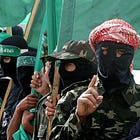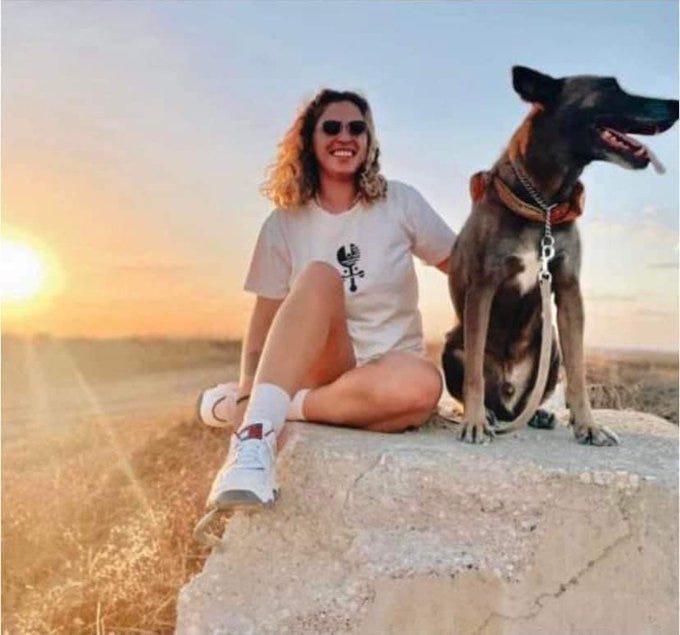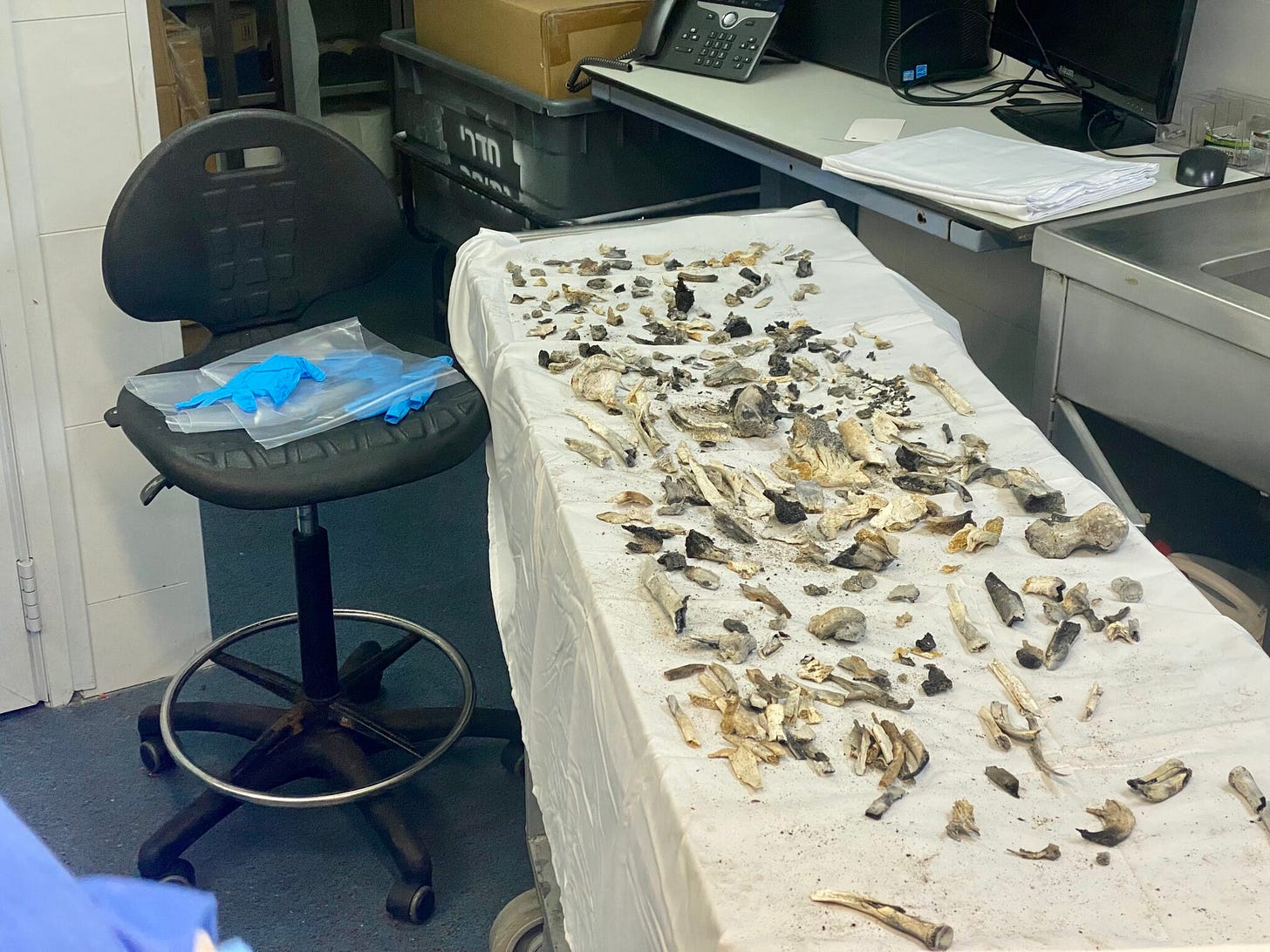In my last post I began to cover the horrific events of October 7, 2023. Click the link to read it.
Today I will complete the coverage. Once again this is a warning that this post contains graphic and disturbing descriptions and images. However, as I said last week, I believe that the events of that horrific day are already fading from the memories of most people not directly involved. We must never forget what happened that day and we must back Israel in their justified vengeance against the barbaric terrorist organization that is Hamas.
Kibbutz Alumim
At 6:30 am, air raid sirens were heard, as well as the sounds of two Iron Dome batteries in the area launching missiles. The IDF ordered the kibbutz’s security team, consisting of 12 civilians, to be activated, and at 6:45 am they received an alert that armed militants were approaching the entrance to Alumim. Nine terrorists on motorcycles arrived at the main gate at 7:00 am, but were unable to open it. They then rode around the kibbutz and broke through a rear gate, allowing them to open the main gate from the inside. They began shooting at passing motor vehicles on the road outside the kibbutz.
The militants then penetrated the southern side of the kibbutz, an area where foreign employees from Nepal and Thailand lived. The security team fired at the terrorists but were unable to assist the workers because they were too far away. The militants entered the foreign workers housing, killed many of them and kidnapped others. Of the 41 foreigners employed as farm workers at Alumim, ten Nepalese and seven Thai workers were killed and one Nepalese and four Thais were kidnapped.
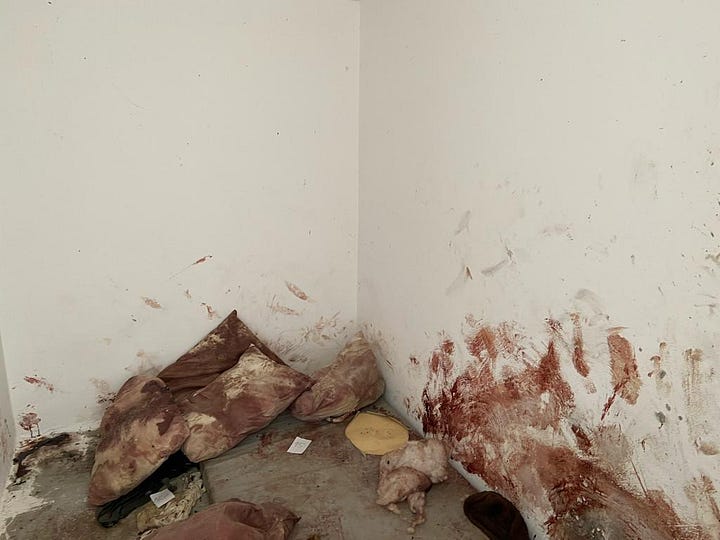
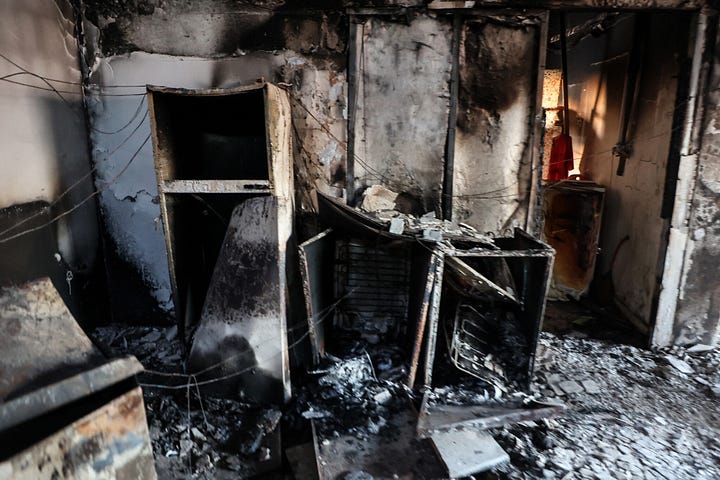
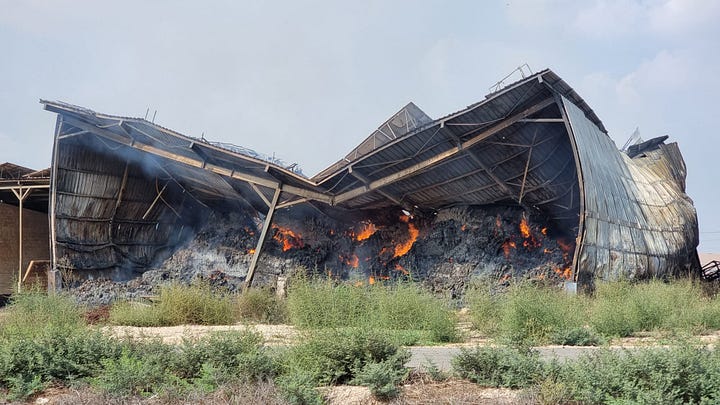

Hamas continued their rampage going to the kibbutz dairy, where they killed some of the cows, burned down the silo, punctured the milk tanks, and burned hay intended for the cows.
At 9:00 am, a number of militants entrenched themselves in a park. The security team engaged them and managed to kill two, including their commander. This stopped the terrorists from entering the area where the Israeli civilians lived. The firefight continued until noon, when the Metzada (Israel Prison Service (IPS) tactical unit tasked with detection and arrest of escaped prisoners) and Yahalom (the special operations unit of the IDF Combat Engineering Corps), arrived and assisted in the elimination of militants. At 12:30 pm, a second group of Hamas gunman arrived at the kibbutz meat packing house where they were confronted by members of Unit 5101 (IAF Special Forces). They fought the terrorist for several hours before killing them all with the help of an attack helicopter.
Kibbutz Kissufim
The morning of the 7th, 70 Hamas fighters entered Kibbutz Kissufim and fought the kibbutz security team killing four of them, including their leader. They then went on a rampage, destroying as many building as possible and killing anyone they could find. When the IDF arrived and cleared the kibbutz, eight Israelis and six Thai workers had been killed, including Gina Semiatich, a 90-year-old woman. She had been dragged out of her house, dragged around by her hair, sexually assaulted, dragged back inside her house and shot in the head.

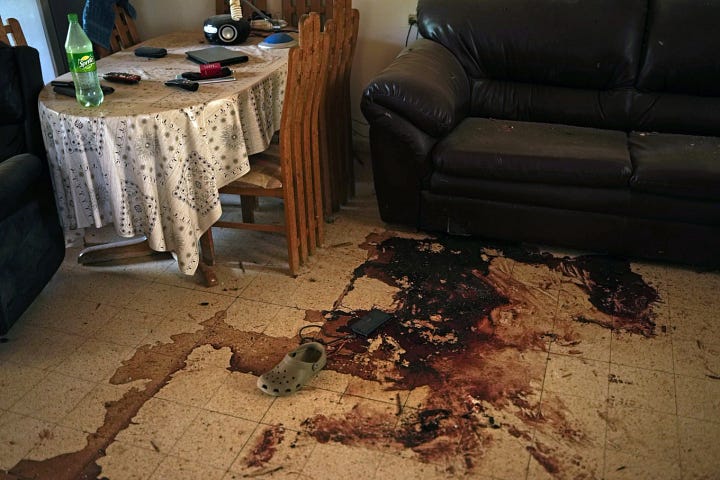
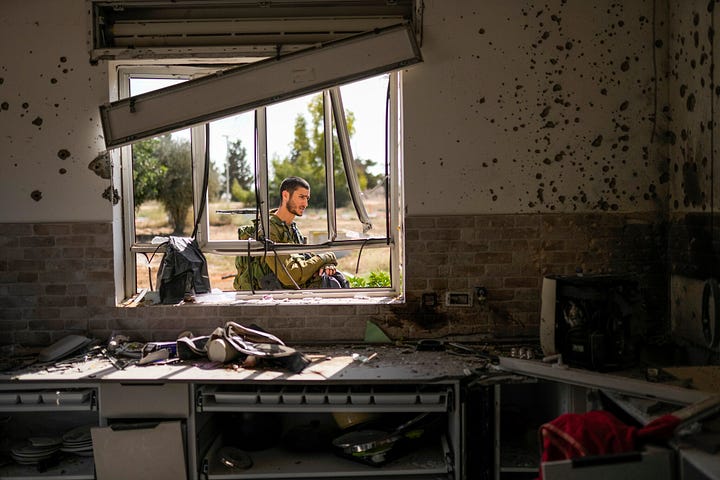
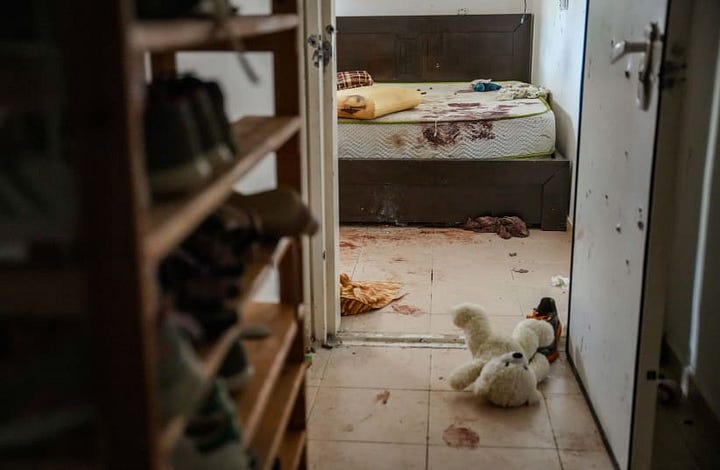
A platoon from the 51st Battalion of the Golani Brigade arrived at the kibbutz, and engaged the terrorists in a battle that lasted several hours. In the late afternoon hours, the soldiers began evacuating kibbutz residents who had been trapped in their safe rooms. Eight soldiers from the platoon were killed in the battle.
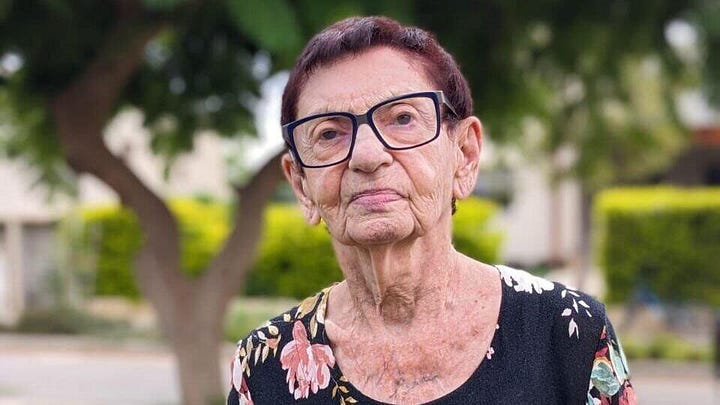
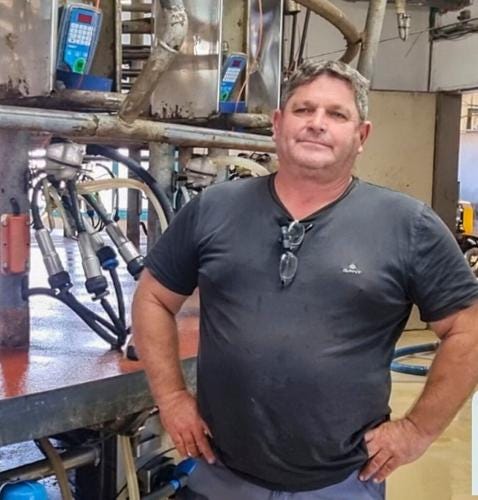
On Tuesday October 9, Reuven Heinik, the kibbutz dairy farm manager, asked the army for permission to enter the dairy farm to feed the cows who had not received food or water for about 60 hours. While at the milking parlor, a militant who had been hiding in the dairy since the attack, shot and killed him.
Moshav Netiv HaAsara
Netiv HaAsara, a moshav founded in 1982, is the closest Israeli community to the Gaza Strip, situated a little over 100 yards from the Palestinian towns of Beit Lahia and Beit Hanon, close enough that residents regularly saw Hamas units training.
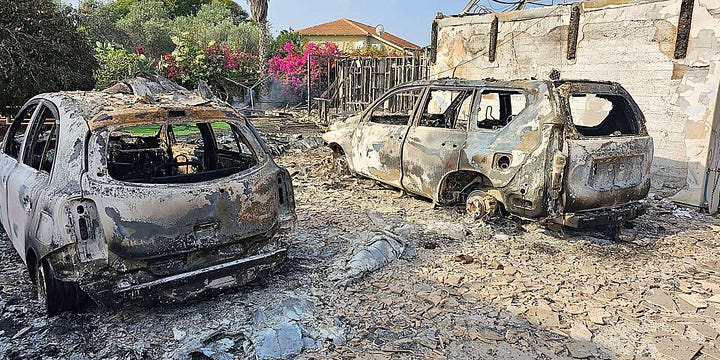
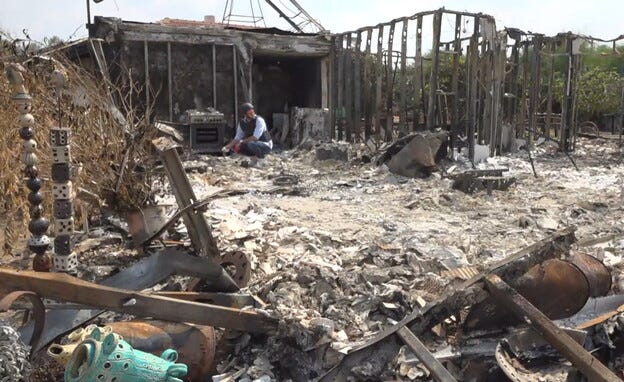
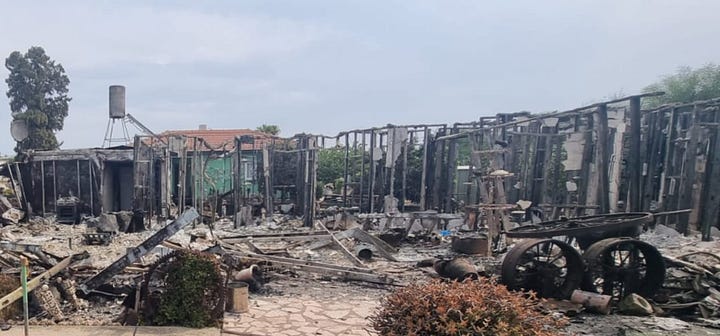
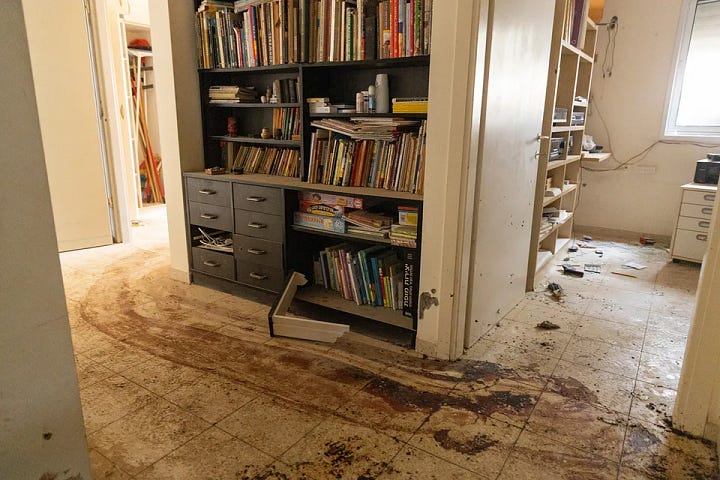
On October 7, a force of 35 Hamas terrorists infiltrated Netiv HaAsara. Six came in on motorized paragliders and the rest in cars. Just like in Nir Oz, many residents had fled to their safe rooms because of the rocket barrage. Because of this, and the lack of power or internet service, residents did not know that Hamas militants had entered Israel. When it was discovered that Hamas was inside the village, it's rapid response team battled the attackers. Three members of the response team and 21 residents were killed in the initial assault. The remaining team members held off the Hamas gunman for six hours before IDF forces arrived in the moshav.
Moshav Yakhini
Moshav Yakhini (a moshav is a, not quite as collective as a kibbutz, collective farm) is located in the northern Negev desert near the city of Sderot. On October 7, a group of Hamas fighter arrived in a truck and attacked the moshav. The leader of the moshav security team, and a Lieutenant Colonel in the IDF reserves, Nir Hajbi, was on vacation in Azerbaijan when he began getting text alerts about the attack. He tried to direct the defense of the moshav by phone but was only partially successful. Seven people, including his own son and a border policeman, were killed and 20 others including an IDF major, were wounded. A force of YAMAM and Flotilla 13 commandos eventually arrived and cleare the moshav, killing all the attackers.
Kibbutz Ein HaShlosha
Ein HaShlosha is a kibbutz in southern Israel near the Gaza border. On October 7, Hamas attacked the kibbutz with a force of 20 terrorists. They destroyed many buildings and managed to kill seven Israelis including an 80-year-old woman, who died after her home was set on fire and she was unable to escape. A 39-year-old from Chile was raped before she was shot eight times and killed, and a 63-year-old grandmother was raped before being beheaded. Hamas also managed to take ten hostages. However, before the terrorists could kill more people they ran into the kibbutz security team, resulting in a standoff that lasted six hours. The leader of the security team was killed in the firefight but eventually Hamas left the area to find easier targets. Three day later when the IDF searched the kibbutz, 30 survivors were discovered, 14 of whom were Thai workers.
Psyduck music festival
Psyduck was a small trance music festival that took place in the open fields between kibbutz Nir Or and kibbutz Nirim, 1.2 miles from the border. This was a separate festival from the much larger Nova festival, I wrote about in Part IX. The rave hosted about 100 participants and were held once every two months, with the location of the party kept a secret until the last minute. In October, 2023, the party was arranged as usual as a covert gathering, without the authorization or knowledge of the police or other authorities.
On the early morning of October 7th, while people were dancing to the sound of music, a rocket barrage began. Partygoers quickly realized that this was no ordinary barrage. Shortly after the rockets started, a motorized Hamas paraglider came near the party venue, but did not attack them. They must have radioed to a group on the ground, because Hamas terrorists arrived at the venue shortly thereafter in vehicles and on foot and began shooting partygoers. As the shooting increased, some of the people began to run away. Some of those who ran, encountered waiting Hamas militants, and were killed while trying to escape. The people that stayed behind tried to hide where ever they could find a place. They hid until the IDF arrived a few hours later. In total, seventeen of the festival participants were killed
Kibbutz Nir Am
One of the few bright spots that hellish day happened a kibbutz Nir Am. When Hamas attacked, the 25-year-old Kibbutz Security Coordinator Inbal Rabin-Lieberman, heard unusual noises near the kibbutz.
She realized the significance of the threat and quickly distributed weapons among the twelve members of the kibbutz civilian quick response group, including her uncle. She ran between houses, organizing men in different ambushes around the perimeter of the kibbutz and developed a plan to protect the settlement. Rabin-Lieberman and her fellow citizens held off the attackers for three hours, killing 25 militants before the IDF arrived. This was the only community bordering Gaza that did not suffer any casualties that day.
Kibbutz Nirim
in the early hours of October 7, a group of 20 terrorists armed with rifles, grenades, and RPGs arrived at kibbutz Nirim. They set houses on fire, shot up others, and hurled grenades inside others. Early in the attack, a group of three IDF soldiers led by Colonel Asaf Hamami entered the kibbutz and battled the Hamas fighters. All three were killed and their bodies were taken to the Gaza Strip. Corporal Amit Levy, a police officer who was on leave at the time, also heard the gunfire and joined the members of the kibbutz security team, fighting the terrorists with his police issued M-16. They eventually retreated to a more advantageous position at the top of a silo. This move caused the terrorists to withdraw outside the kibbutz. As additional Hamas forces arrived in vans and on motorcycles, it appeared that Hamas was going to make another push into the kibbutz. Luckily for the kibbutzniks, an IDF attack helicopter arrived on scene. The helicopter radioed the security team and told them to confront the terrorists still inside the kibbutz, while the helicopter would carry out airstrikes on targets outside the fence. This engagement lasted two hours, and kept Hamas from killing even more Israelis then they did. Seven hours after the start of the attack, IDF troops arrived to complete the clearing of the kibbutz, they found and killed nine terrorists that had been hiding in the kibbutz.
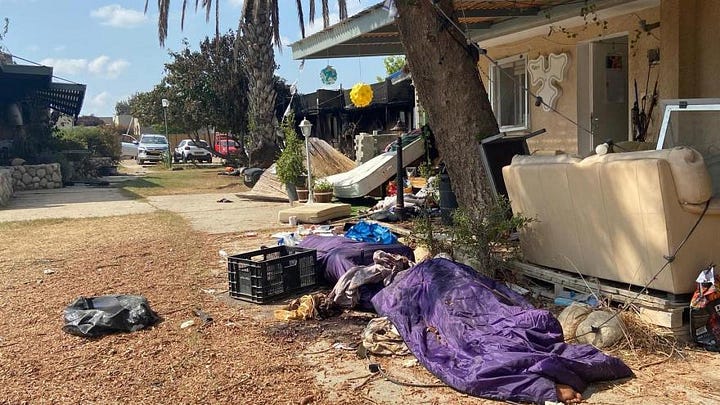
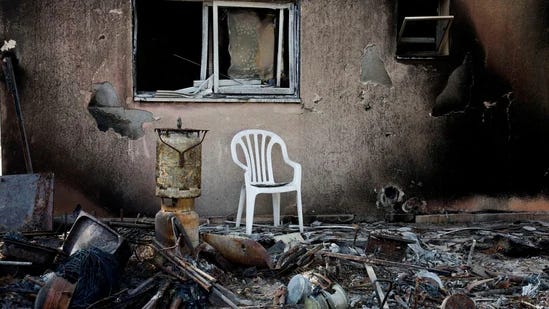

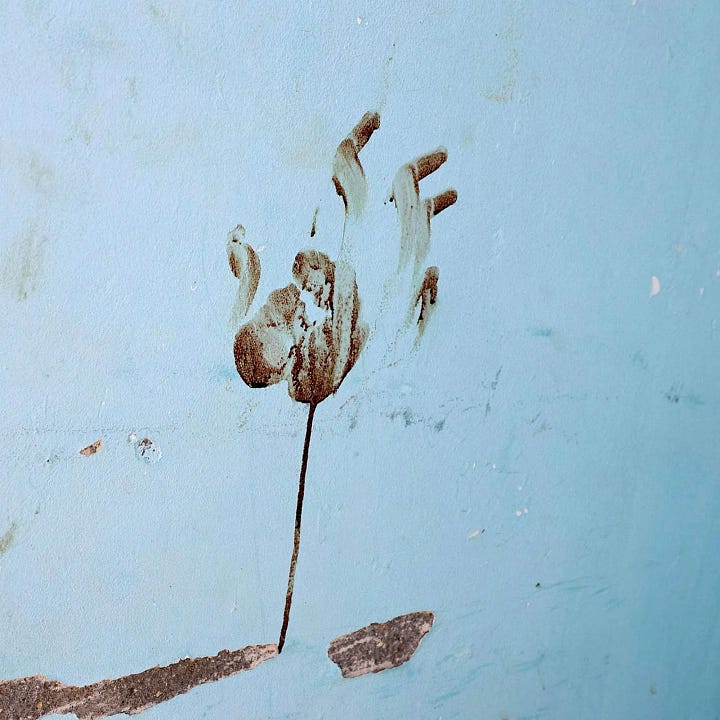
Seven people were killed in the attack and 45 were wounded. The exact number of people that were taken hostage is not known but it is believed, that at least ten people were taken back to Gaza. The kibbutz was also very badly damaged and a crowdfunding campaign raised a half million shekels in five days for the rebuilding.
Kibbutz Holit
At 6:30 in the morning Hamas terrorists invaded the kibbutz. What happened here was repeated across Israel that day. After entering the kibbutz, Hamas began a house by house attack, at the start of the attack many residents were still asleep or eating breakfast. As Hamas went house to house they would shoot at the metal shutters of safe rooms to determine if they were occupied. If they heard a scream or yell they would attempt to breach the safe rooms using grenades. If they breached the door they would kill all the occupants, without regard to age or sex. In several instances they returned to houses and set them alight to force any occupants to exit.
It does not appear that the security team of the kibbutz was activated and while a number of residents were known to have weapons, only two are reported as actively using them against the militants. Shimon Azoulai, a resident, had a weapon and fought militants "where he could’, but he said he did not have much impact. Avi Korin, the only member of the security team mentioned in reports, did fight Hamas with unknown effectiveness.
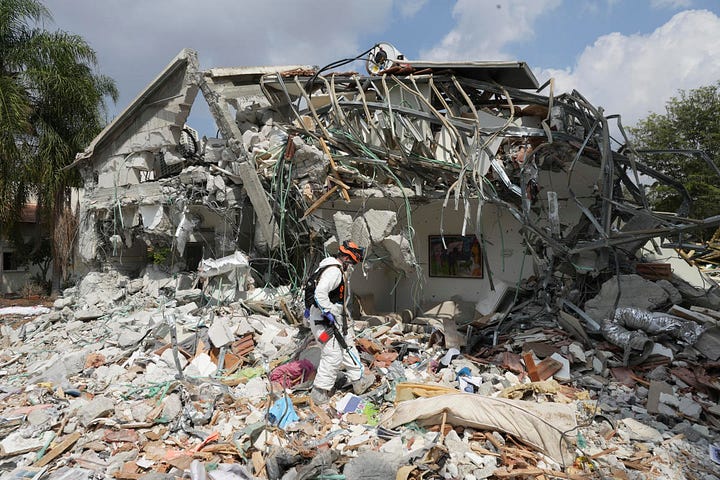
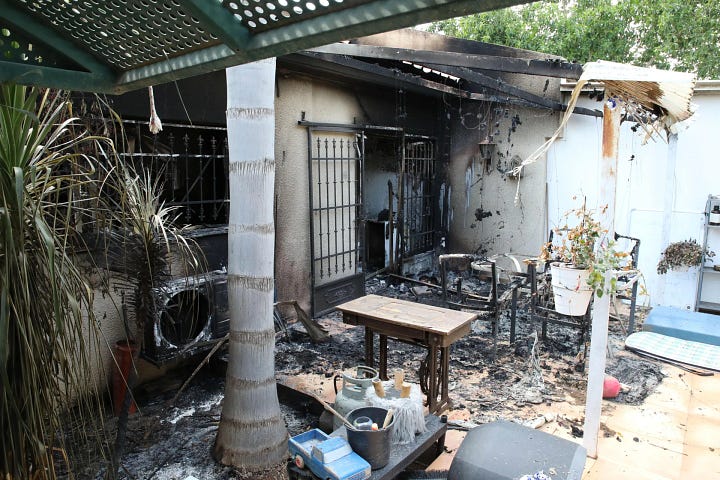

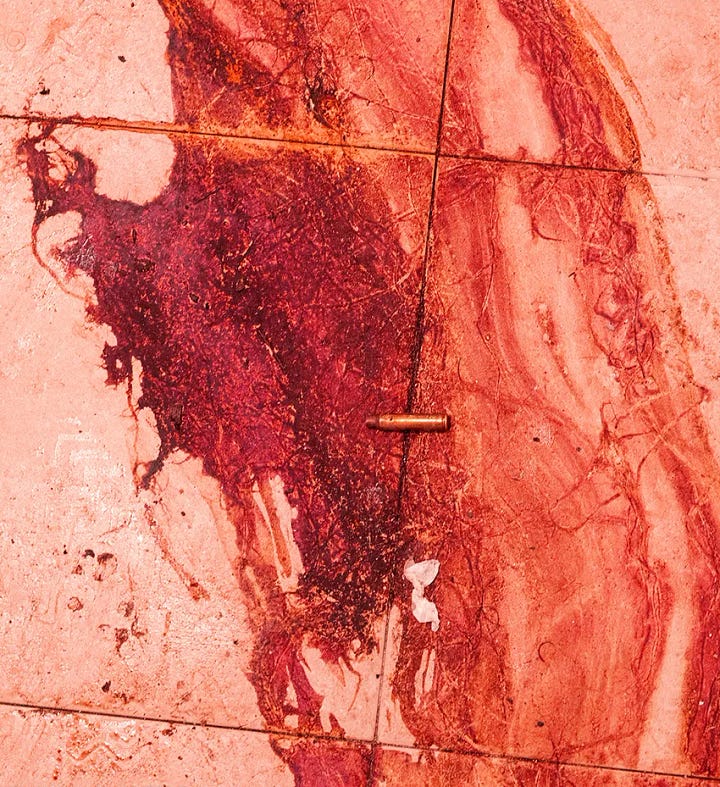
Michael Raitzin, a resident of the kibbutz, and the head of the criminal investigation unit in the largest Bedouin city in Israel, Rahat, which is close to the kibbutz, was on leave in the day of the attack. He heard from his colleagues at around 7:30 that an incursion had occurred, although at that time he did not realize the scale. Armed with his service pistol, he prepared to go and assist in Rahat. However, when he got to his vehicle he observed 20 heavily armed militants. Realizing he could not fight them with his handgun, he fired random shots to distract them, and managed to return to his house via an indirect route. He spent the rest of the day at the window of his house guarding his wife and children, but his house was not attacked. However, many other houses in the kibbutz were attacked. Rotem Mathias (16) describes his mother hiding him under a blanket and lying on top of him to protect him as they heard militants outside. He heard the militants break in and kill both his parents, he played dead and the terrorists moved on. Anat Dymshits (45) and her father, Yosef Rozhansky (67), were hiding in her safe room with her mother, grandmother, her four children and their dog. They describe how militants tried to breach the room by throwing a grenade at the door. Although the militants were unsuccessful at gaining entry, shrapnel from the grenade went under the door injuring the three elderly adults and one of her daughters.
After militants broke into her home, Adi Vital-Kaploun somehow convinced the terrorists to spare her 4-year-old and 4-1/2 month-old sons and take them to a neighbor before the terrorist killed her in front of the children. Avital Aladjem was hiding in her house with her neighbor Hayim Katsman. When Hamas broke into her house, Katsman was killed and Aladjem was discovered hiding in a closet and taken captive. The gunmen then brought her the Vital-Kaploun children from next door, and began walking the three of them through the kibbutz. Aladjem did not know that Vital-Kaploun had been killed. Later on she recounted the ordeal. “Everything was destroyed and full of blood; they took us from house to house with shooting all around, as they burned the houses and the cars.” With one of the terrorists carrying the screaming 4-year-old on his shoulders and Aladjem holding the infant, they were marched to the fence surrounding the kibbutz and then on toward the Gaza Strip. “Me and the kids and the terrorists, quick, quick, they kept saying.” said Aladjem. After the terrorists brought Aladjem and the children into Gaza, they left them standing alone. Thinking on her feet, Aladjem turned around with the children and began walking with them back to the kibbutz. She passed more gunmen and hid with the children in the sand dunes, slowly making her way back. When they entered the kibbutz, Aladjem saw other kibbutz members leaving in their cars and told the 4-year-old that he would see his father soon. The three were taken to the nearby community of Gvulot, where the children were eventually reunited with their father.
In another incident, husband and wife Nir and Adam and their children survived because Adam was able to hold the door shut against militants trying to gain entry. Naama and Gideon Kovani sheltering in their safe room heard that their next door neighbour had been killed and her daughter was hiding in a closet. Naama encouraged Gideon to save the child, which he managed to do without incident.
Twelve residents of the kibbutz, including a Holocaust survivor, a member of the kibbutz security team and Israelis with dual nationality from the US, Canada and Argentina were killed. Three foreign workers, one Moldavian, who was the caregiver for the Holocaust survivor, and two Nepalese workers were killed. Seven people were taken taken hostage, Two of the hostages were released during the first hostage exchange and two hostages remain in captivity.
Kibbutz Nir Yitzhak
At 6:30, kibbutz residents were awoken by air raid sirens and a large amount of Iron Dome activity. They took shelter in their safe rooms, for what they expected to be a short period. At 6:50 the Kibbutz security team were alerted to a potential attack and told to keep their two-way radios on. Seven members of the team took up defensive positions along the western fence of the kibbutz. They expected, at most, an attack on foot from Gaza, and, at worst, an attempt to breach the kibbutz fence and believed they were in a good defensive position to ward off such an attack. The security team were unaware that the Hamas Nuseirat Battalion had arrived in vehicles at the front gate of the kibbutz and had gained entry and set up sniper positions around the area. A kibbutz resident living near the gate saw fifteen militants entering the kibbutz. After returning to his safe room where his family were sheltering, he warned his neighbours what was happening on WhatsApp.
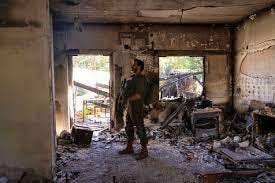
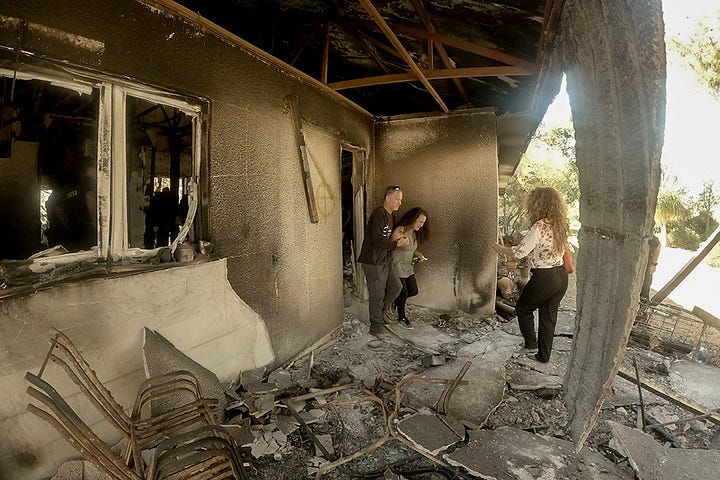
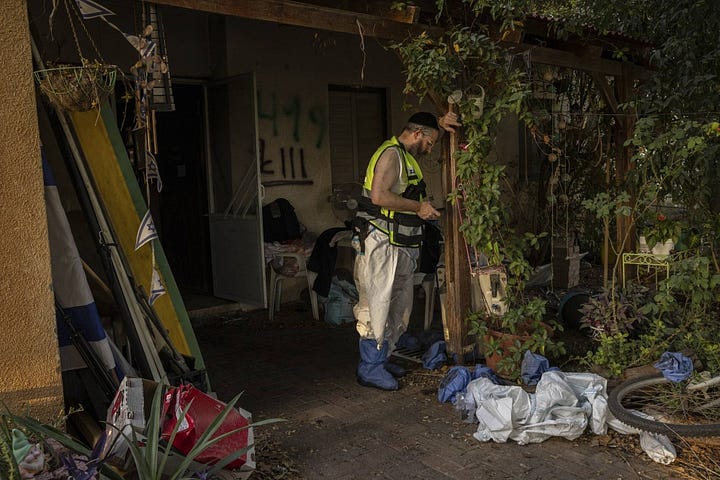
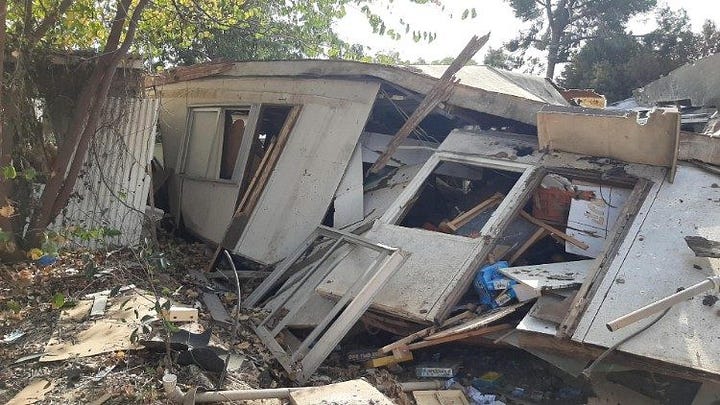
The Hamas militants were seen on video attempting to lure workers in the Chemada chemical factory out of the building by lighting bales of paper in front of the factory, on fire. This was unsuccessful because the workers and security barricaded themselves on the main factory floor, and knew better than to come out. The terrorists damaged other parts of the factory and took equipment but the factory was able to resume production after the kibbutz was secured.
The security team sent a member to investigate the smoke coming from the factory, and when he did not return, sent another one. Both of these people were killed by the snipers Hamas had emplaced around the front gate. It was only then that the security team began to understand the unprecedented scale of the attack. Even without IDF support the kibbutz security team engaged the terrorists in an attempt to protect the residents. The team managed to drive off the militants who left with seven hostages, including an elderly couple, when they arrived on foot at the breached Gaza border fence, they argued that they could go no further because of their injuries. The terrorists allowed them to return to the kibbutz.
After Hamas left, Palestinian civilians took their place, looting anything of value and carrying it back to Gaza. When the IDF arrived twelve hours after the attack began the kibbutz residents had been locked in their safe rooms for over 14 hours, without access to water, food or sanitation. Unit 707 (soldiers from the nearby anti-terrorism school), cleared the kibbutz and protected residents overnight. The kibbutz was evacuated the next day. Five members of the kibbutz security team were killed in the attack but their valiant efforts spared any other residents from death.
Attack on Re'im military base
At 10 a.m., less than five hours after the attacks began, fighting was reported at Re’im military base, headquarters of the Gaza Division. It was later reported that Hamas took control of the base and took several Israeli soldiers captive before the IDF regained control later in the day. The base was reportedly the location of IDF drone and surveillance operations. Hamas reportedly posted video of dead Israeli soldiers it had killed at the base.
On October 8, in a perfect example of a closing the barn door after the horses have left moment, the Israeli government declared the border towns and kibbutzes an active military zone, closing them all off and evacuating the remaining residents.
Casualties
Deaths

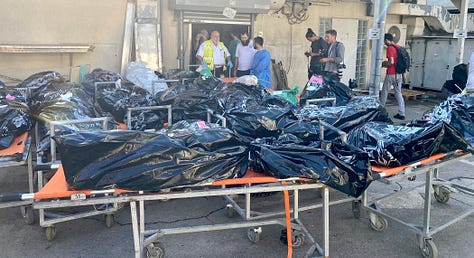
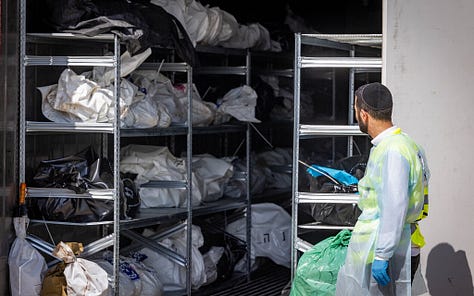
As of this writing there were 1,270 Israelis killed on October 7. The initial number was over 3,000 but in the chaotic environment just after the attack, victims were identified more than once, dead terrorist were identified as Israelis and other mistakes were made. According to Chen Kugel, head of the Abu Kabir Forensic Institute, hundreds of bodies arrived at the institute in a state "beyond recognition". Pathologists were required to process, among others, bone fragments recovered from fires, a blood-soaked baby mattress, victims who were tied, then executed, and two victims who were tied, then incinerated alive.
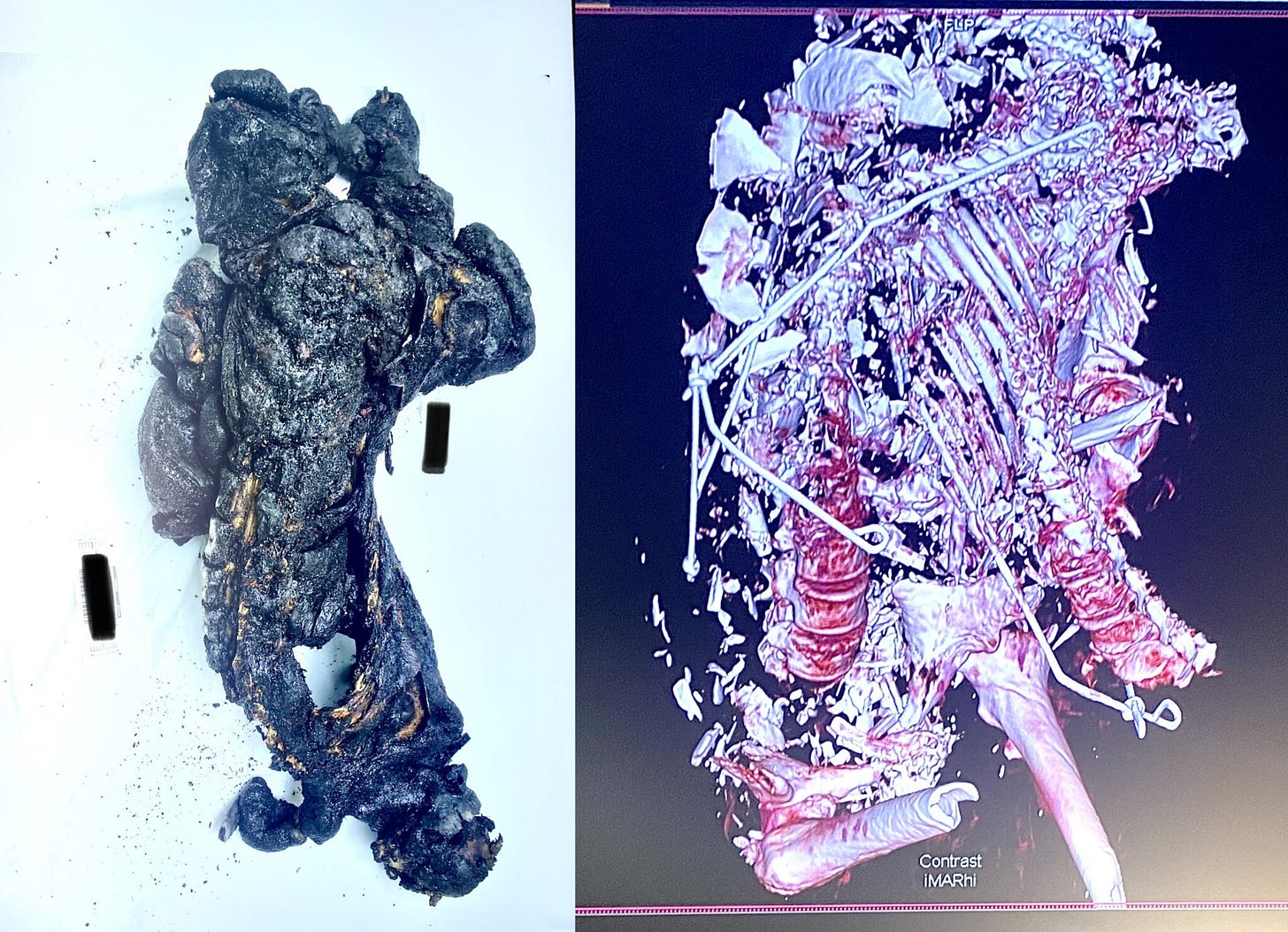
With hundreds missing and bodies burned beyond recognition, Israeli authorities assembled recovery teams from across society. This included archaeologists from the Israel Antiquities Authority, who identified and removed ancient remains in attempts to sift through ash and rubble for bone fragments other forensic teams overlooked. The sheer number of casualties overwhelmed authorities. Bodies were brought chaotically to the Shura IDF base and Abu Kabir forensic institute. The different military, police, and civilian teams caused confusion. Archeologists were brought in and systematically searched rooms, dividing them into grids and carefully extracting bone shards. At one house in Be’eri, the archeology team found a bloodstain under ash that they determined was the outline of a body. It was later identified by DNA analysis as 73-year-old IDF veteran, Meni Godard, his wife Ayelet had also been killed that day.
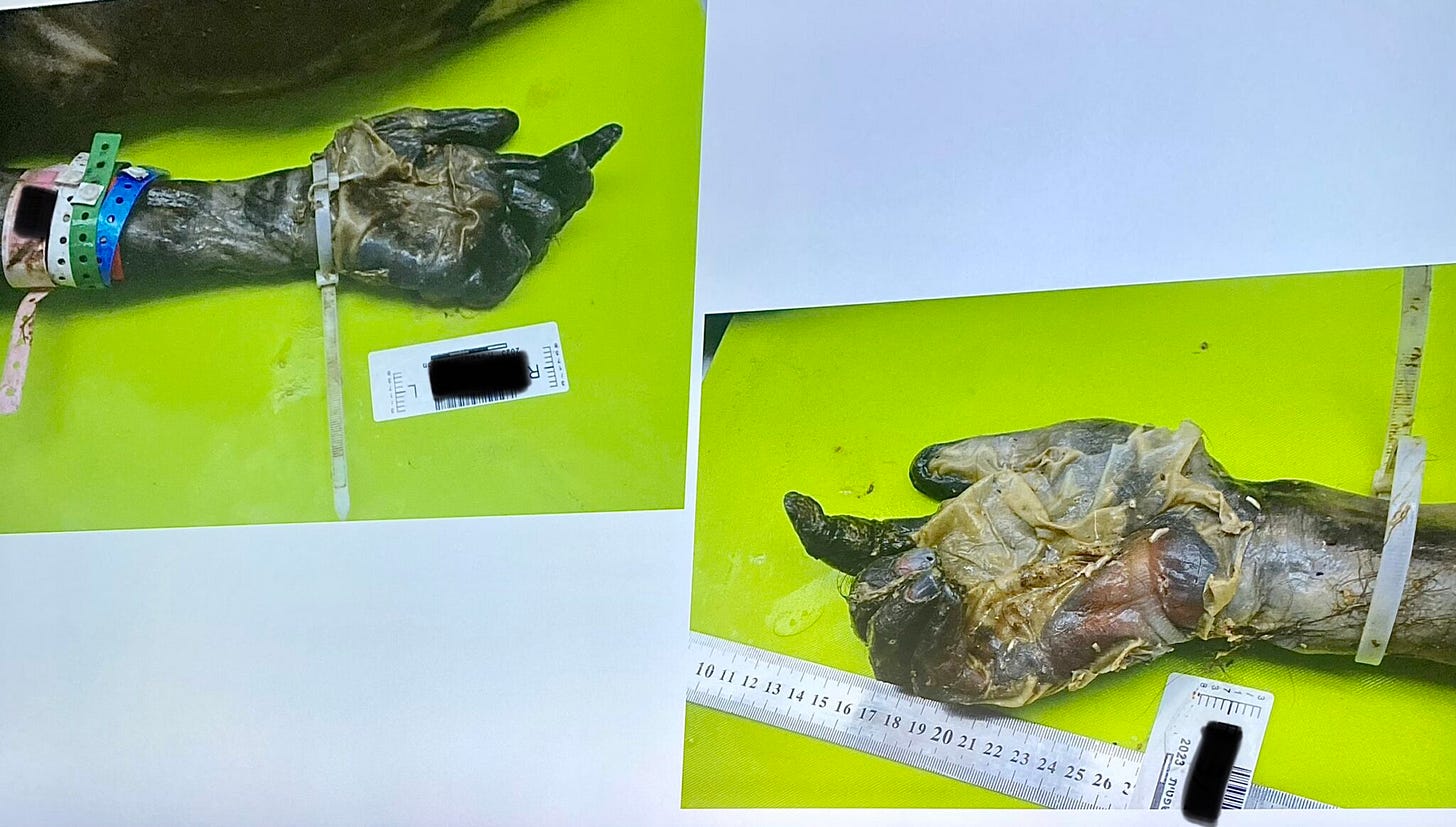
There was so much potential for confusion, the situation was very different from a plane crash, when you know how many people were on board. In this case the picture is blurred. The scientists don’t know whether the missing are hostages in Gaza or dead, their bodies not yet recovered or identified. In some instances, entire families were wiped out, so it is difficult to compile comparative information – medical and dental records, DNA profiles – to which remains can be matched.
It is very possible that the number of people killed on October 7, will go up. Either way, the 1,207 Israelis killed, are still the largest number of Jews killed in a single day since the Holocaust. There were 695 Israeli civilians killed, 10 Shin Bet (Israeli FBI) agents, 59 police officers and 373 members of kibbutz security teams. The deaths included 14 children under 10, including a ten-month-old baby, and 36 adolescents between the ages of 10 and 19, as well as 40 people over 61. It wasn't just Jews that were killed by the Hamas barbarians, there were also 70 Arab-Israeli citizens killed, many of whom are Bedouin. Also among the dead were 71 foreign nationals from countries all over the world, including at least 30 US citizens.
Injuries
There were 2,437 Israelis injured on October 7, and those only count the physical injuries. There is no way to calculate the emotional toll the attack took on those who survived or those who are still being held in Gaza.
Hostages
Hamas took at least 247 Israelis hostage and transported them to Gaza. On October 8, Palestinian Islamic Jihad, who had also participated in the attacks, announced it was holding at least 30 captives. Videos from Gaza showed Gazan residents cheering trucks carrying hostages as well as dead bodies. In fact there have been many reports from captives that were released that they were held by “regular Gazans”. For example, Mia Schem, who was shot in the arm and abducted from the Nova music festival, said her captors brought her directly to a hospital in Gaza as she was bleeding to death although she received no medical attention there. She was then taken to a private home where a man and his family held her captive with “pure hate,” forbidding her to speak, cry or move. She would go days without receiving food and was never allowed to bathe. “I experienced hell. Everyone there are terrorists,”Schem said. “There are no innocent civilians, not one.” In another example Sharon Aloni Cunio recalled how she and her twin three-year-old daughters were mobbed on October 7, as terrorists brought them into Gaza on a tractor from their home in Nir Oz. “People start beating everyone who was sitting on the tractor — just beating us, from all sides. It was horrific,” she said. This contradicts the prevailing narrative that there are “good Palestinians” and separate from them, the “bad” Hamas members.
Around half of those hostages were released during a short-lived November truce, but 132 remain in Gaza and 25 have died in captivity. The youngest hostage taken, Kfir Bibas, who was taken along with his father, mother and brother from Nir Oz, turned one on January 18, meaning he has spent 1/4 of his life as a hostage of Hamas.
Propaganda
The videos released by Hamas of the attacks, the dead being paraded around Gaza and the hostages are a deliberate and sophisticated propaganda campaign aimed to induce feelings of "helplessness, paralysis, and humiliation" in the Israeli population. When those videos go viral, it leads to an amplification of the Hamas narrative. In a New York Times column, Nicholas Kristof discussed the video as a cause of the psychological trauma and anger experienced within Jewish communities in the aftermath of the attacks, feelings which I believe are completely justified. However, the videos did not have the intended effect, the video showing Shani Louk, did not demoralize Israeli society; instead, her treatment at the hands of her captors drew widespread revulsion and condemnation, and if anything, strengthened Israeli resolve to exact retribution.
Advance Israeli knowledge
According to The New York Times, Israeli officials had obtained detailed attack plans more than a year before the attack. The document described operational plans and targets, including the size and location of Israeli forces, and raised questions in Israel about how Hamas learned these details. The document provided a plan that included a large-scale rocket assault before an invasion, drones to knock out the surveillance cameras and automated guns that Israel has stationed along the border, and gunmen invading Israel, including with paragliders. "Hamas followed the blueprint with shocking precision", according to The Times. The document was widely circulated among Israeli military and intelligence leadership, who largely dismissed the plan as beyond Hamas's capabilities, though it was unclear whether the political leadership was informed. In July 2023, a member of the Israeli signals intelligence unit alerted her superiors that Hamas was conducting preparations for the assault, saying, "I utterly refute that the scenario is imaginary". She sent her concerns up the chain of command but her commander, an Israeli colonel, ignored her concerns. However, Shin Bet and IDF commanders discussed a possible threat to the Nova music festival near kibbutz Re’im just hours before the attack, but the festival's organizers were not warned. It appears that Israel fell victim to one of the most common pitfalls in warfare, complacency. There have been many nation throughout history that have believed that either that the defenses were too strong, or their enemy too weak, to attack them. Just like the French in World War II, who believed that the Maginot line would protect them, or the Hessians in the Revolutionary War, who believed that the Colonials were too weak to attack them the day after Christmas, the Israelis believed that their high tech border defenses would protect them and that Hamas did not have the ability to launch a massive attack. They were proven wrong on both accounts and the mistake has cost them very dearly.
As I said at the beginning of this post, the recounting of the events of October 7, 2023, is horrific, disturbing and emotional, but it is needed. The events of that day are already fading, and with that the outrage fades. When the outrage fades, the more vocal, pro-Hamas elements out there, gain ground and put more pressure on Israel. That pressure makes it harder for Israel to complete their mission of utterly destroying the evil terrorist barbarians that are Hamas. I, for one fully and completely support Israel in their effort to rid the world of an organization that not only threatens Jews the world over, but also the entirety of Western Civilization.
Next time I will address the Israeli response to this unprecedented slaughter. I hope you are learning a few things from these posts and please share them with as many people as possible.
Chris





